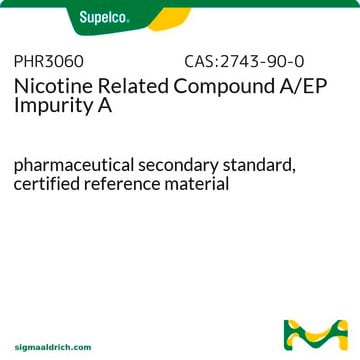おすすめの製品
グレード
pharmaceutical primary standard
APIファミリー
nicotine
メーカー/製品名
EDQM
アプリケーション
pharmaceutical (small molecule)
フォーマット
neat
保管温度
−20°C
SMILES記法
CN1CCC[C@H]1C2=CC=CN=C2.C
InChI
1S/C10H14N2.CH4/c1-12-7-3-5-10(12)9-4-2-6-11-8-9;/h2,4,6,8,10H,3,5,7H2,1H3;1H4/t10-;/m0./s1
InChI Key
RYYKFQGHMYGLEL-PPHPATTJSA-N
類似した製品をお探しですか? 訪問 製品比較ガイド
詳細
アプリケーション
生物化学的/生理学的作用
包装
その他情報
関連製品
シグナルワード
Danger
危険有害性情報
危険有害性の分類
Acute Tox. 2 Inhalation - Acute Tox. 3 Oral - Aquatic Chronic 2 - Eye Irrit. 2 - Repr. 2
保管分類コード
6.1A - Combustible acute toxic Cat. 1 and 2 / very toxic hazardous materials
WGK
WGK 2
引火点(°F)
289.8 °F
引火点(℃)
143.2 °C
適用法令
試験研究用途を考慮した関連法令を主に挙げております。化学物質以外については、一部の情報のみ提供しています。 製品を安全かつ合法的に使用することは、使用者の義務です。最新情報により修正される場合があります。WEBの反映には時間を要することがあるため、適宜SDSをご参照ください。
毒物及び劇物取締法
毒物
Jan Code
Y0001023-1.25MG:
Y0001023-1EA:
Y0001023:
Choose from one of the most recent versions:
試験成績書(COA)
Sorry, we don't have COAs for this product available online at this time.
If you need assistance, please contact カスタマーサポート
この製品を見ている人はこちらもチェック
ライフサイエンス、有機合成、材料科学、クロマトグラフィー、分析など、あらゆる分野の研究に経験のあるメンバーがおります。.
製品に関するお問い合わせはこちら(テクニカルサービス)










